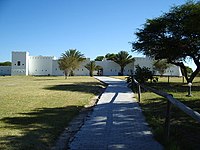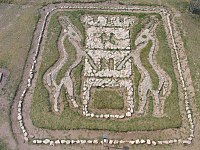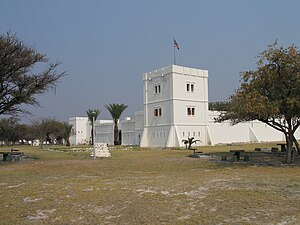Fort Namutoni
| Fort Namutoni | ||
|---|---|---|
|
National monument in Namibia |
||
| Monument type | Historical and Military Sites: Military forts and territories | |
| location | Etosha National Park | |
| Geographic coordinates : | 18 ° 48 '29.2 " S , 16 ° 56' 25" E | |
|
|
||
| Emergence | 1897 | |
|
Recognized by the National Heritage Council |
February 15, 1950 | |
| Deprivation | ||
| Sponsorship | Namibia Wildlife Resorts | |
| Website | NHC Namibia | |
The namutoni (often only Namutoni ) is in the southeast of today's Etosha National Park in Namibia situated former police and military station. Today it is the visitor center of the national park and an overnight camp for visitors. The name corresponds to the freely translated "high place" in the Ovambo language , as the source is located on a limestone hill.
Like Okaukuejo, Namutoni was set up in 1897 by the German colonial administration at the time in German South West Africa to mark the northern border of the German areas of influence and as a control point against the penetration of rinderpest from the northern Ovambo areas . In 1901/1902, a fortified structure for the military was built 100 meters from the source , which is why it is also called Fort Namutoni . It formed the eastern link in the chain with Fort Sesfontein and Okaukuejo.
After the beginning of the Herero uprising in 1904, the military garrison of the fort was largely withdrawn in order to support the farmers in the south of the country who were harassed by the insurgent Herero . Only a "stable guard" of four soldiers and three farmers remained, which was considered sufficient, as the Ovambo north of Namutoni were considered peaceful and had not yet participated in the Herero uprising. But there were rumors that the Herero wanted to include the Ovambo in the uprising.
"According to the Finnish missionaries, messengers are said to have brought urgent requests from the Herero leaders to the kings and leaders of their relatives."
Should this historical statement stand up to scrutiny, only the tribe of Ondonga , who had their headquarters north of the salt pan, would have been the only Ovambo tribe to take part in the uprising.
The surprise in the fort, barely occupied by only 7 soldiers, was in any case great when this tribe attacked lyaMpingana on January 28th with 500 well-armed and equipped warriors led by King Nehale . However, the small crew managed to repel the first onslaught of the Ovambo and shoot around 60 warriors. When the Ovambo then withdrew temporarily, the defenders of the fort managed to break out unnoticed under cover of night and escape to Tsumeb, 100 km away . The now unoccupied Fort Namutoni was stormed by the Ovambo the next day and largely destroyed, but rebuilt from 1905 to 1907 by the German protection force .
In addition to the historical statement that the Ovambo provided protection for the Herero, another reason for this attack is suspected to be a not unfounded rumor that the German colonial administration was considering the shooting of all Ovambo cattle in order to stop the further spread of rinderpest that was rampant there.
During the First World War , the fort served as a prison camp for British soldiers until it was handed over to the South African Army in 1915 and subsequently fell into disrepair. Only with the establishment of the Etosha National Park did the dilapidated fort regain importance; it was rebuilt and declared a national monument in 1950. In 1957 it was initially designed as a base for the park administration and as a very simple rest camp for visitors to the national park, which is only open in the winter months. The fort itself was partially converted into a museum and is now an official national monument of Namibia. The tourist infrastructure was gradually expanded and improved so that year-round accommodation was made possible.
Since the mid-2010s, the fort has largely been left to decay.
Guest business
| Namutoni Camp | |
|---|---|

|
|
| Hotel chain | Namibia Wildlife Resorts |
| Website | www.nwr.com.na |
| Hotel information | |
| building | Fort Namutoni |
| owner | Namibia Wildlife Resorts |
| Furnishing | |
| room | 44 |
| Restaurants | 1 |
| Bars | 1 |
The fort and the surrounding land have been operated by the state-owned Namibia Wildlife Resorts since the mid-1960s as a hotel under the name Namutoni Resort (formerly Namutoni (Rest) Camp ). The camp was completely renovated in 2011 and was renovated again from mid-2014 to early 2015.
literature
- Bernd Längin: The German colonies . Mittler ES + Sohn, 2005, ISBN 978-3813208542 , p. 130.
- Nikolai Mossolow: Die Geschichte von Namutoni - Die Verhaal van Namutoni - The History of Namutoni , Windhoek 1971, John Meinert Printing.
- Gerhard Seyfried: Herero , Aufbau Taschenbuch Verlag, 2004, ISBN 978-3746620268 , p. 370 ff.
- Andreas Vogt : From Tsaobis to Namutoni - The fortifications of the German protection force in German South West Africa from 1884-1915 , Windhoek 2015, ISBN 978-99916-57-09-7 .
Web links
Individual evidence
- ↑ Namatoni on a map from the time of German South West Africa
- ↑ a b Dr. E. Th. Förster: "The Ovambovolk" in From Rock to Sea / The Wide World (weekly edition), August Scherl Verlag, 23rd year Stuttgart, May 1904
- ↑ Fort Namutoni in Etosha Park falls into disrepair. Namibiana.de, May 16, 2015.
- ↑ Camp is a shame. Allgemeine Zeitung, February 2, 2016.




